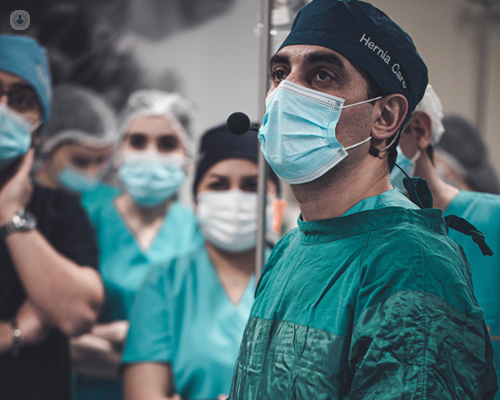The benefits of keyhole surgery for hernia
Escrito por:Keyhole surgery, also known as laparoscopic surgery, is a minimally invasive technique frequently used for hernia repairs. By using small incisions, this technique allows surgeons to insert a laparoscope (a small camera) and specialised surgical tools to repair the hernia, without the need for a large open incision. Keyhole surgery is commonly chosen over open surgery due to several significant advantages.

What’s involved in keyhole surgery for hernia?
In keyhole hernia surgery, the surgeon makes three small incisions near the hernia site. A thin tube with a camera, called a laparoscope, is inserted into one incision to provide a clear, magnified view of the hernia and surrounding tissues. Through the other incisions, the surgeon inserts specialised instruments to gently move aside any protruding tissue or organs and repair the hernia. In most cases, a mesh is placed over the weakened area to reinforce it, helping to prevent recurrence. Once the repair is complete, the small incisions are closed, typically requiring only a few stitches.
What are the benefits of keyhole hernia surgery?
1. Smaller incisions, less scarring
- Unlike traditional open surgery, which often requires a large incision, keyhole surgery involves small incisions of about 0.5 to 1 cm. This minimally invasive approach leads to reduced scarring, which is beneficial for both cosmetic reasons and long-term skin integrity.
2. Reduced postoperative pain
- Since keyhole surgery causes less trauma to the tissues and muscles around the hernia site, patients generally experience less postoperative pain. This often translates into a lower need for pain relief medications and a more comfortable recovery experience.
3. Shorter hospital stay and quicker recovery
- Many patients undergoing keyhole hernia repair can return home the same day or within 24 hours. Recovery times are also shorter compared to open surgery; patients can typically resume light activities within a week and return to their normal routine within a few weeks, making it especially suitable for those looking for a quicker return to work or daily activities.
4. Lower risk of infection
- The smaller incisions in keyhole surgery lower the risk of wound infection, as there is less exposed tissue. Minimised contact with the external environment also reduces the chance of postoperative infections, which can lead to complications and prolonged recovery.
5. Improved precision and reduced recurrence risk
- The laparoscopic camera provides surgeons with a magnified, high-resolution view of the hernia and surrounding tissues, enabling them to repair the hernia more precisely. This precision can contribute to a lower chance of hernia recurrence, particularly for patients with bilateral or recurrent hernias.
6. Better outcomes for certain types of hernias
- Keyhole surgery is often the preferred method for treating inguinal, umbilical and bilateral hernias. It is especially advantageous for repairing hernias that have recurred after open surgery, as the laparoscopic technique allows surgeons to avoid the scar tissue from previous surgeries.
Is keyhole surgery suitable for everyone?
While keyhole hernia repair offers numerous benefits, it may not be suitable for everyone. Patients with large or complex hernias, or those with certain medical conditions, may require open surgery. A specialist will assess your case to determine the best surgical approach based on your specific type of hernia and overall health condition.
Keyhole surgery has become a widely recommended approach for hernia repair, offering advantages in terms of recovery, comfort and cosmetic outcomes. However, consulting with a specialist will provide the most accurate guidance tailored to your needs.


